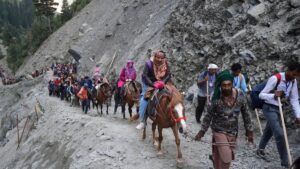Table of Contents
Thailand’s Kra Isthmus
Context: Srettha Thavisin, Thai Prime Minister, proposes a land bridge across Thailand to shorten maritime shipping routes.
About Kra Isthmus
The Kra Canal, alternatively known as the Thai Canal or Kra Isthmus Canal, is a planned waterway project intended to link the Andaman Sea directly to the Gulf of Thailand, traversing the southern region of Thailand’s Kra Isthmus.
- Location: Southern Thailand, separating the Malay Peninsula
- Width: Approximately 44 km
- Geographic Features: Connects Andaman Sea (west) to South China Sea (east)
- Historical Context of the Thai Canal Concept
- Origin of the Idea: The concept of connecting Thailand’s two seas dates back to 1677 by King Narai the Great of the Ayutthaya Kingdom, long before the Suez Canal’s impact on European maritime trade.
- King Narai’s objective was to facilitate swift military movements to defend against Burmese aggression.
- Early Assessments and Colonial Interests: French collaboration was sought, but the feasibility report by a French engineer negated the possibility, halting the project. Later, British and French explorations from 1843 to 1883 aimed at finding a viable maritime passage aligning with their colonial agendas.
- Origin of the Idea: The concept of connecting Thailand’s two seas dates back to 1677 by King Narai the Great of the Ayutthaya Kingdom, long before the Suez Canal’s impact on European maritime trade.
- Modern Proposal: In 2021, the Thai government introduced a fresh initiative—the “Thai Land Bridge.”
- This modern proposal envisions a 90-kilometre land bridge, including road and rail networks connecting ports on each coast, aiming to cut the journey by 1,200 kilometres and 2-3 days, bypassing the congested Strait of Malacca.
We’re now on WhatsApp. Click to Join
Dynamic Ground Water Resource Assessment Report
Context: The Union Minister of Jal Shakti has released the Dynamic Ground Water Resource Assessment Report for the entire country for the year 2023.
Key Findings Of the Report, 2023
- Assessment of Groundwater Units
- Total Units Evaluated:
- Over-exploited Units: 736 units (11.23%), showing a decrease. These units extract more groundwater annually than the available resource.
- Safe Units: 4793 units, indicating sustainable usage levels.
- Rise in Groundwater Recharge
- Current Status: 449.08 billion cubic metres (BCM) annually.
- Comparison with Previous Year: Increase of 11.48 BCM from 2022.
- Increase in Annual Groundwater Usage
- Total Extraction:34 BCM annually for national usage.
- Reduction in Groundwater Extraction Rate
- Present Rate: 59.23%.
- Note: This rate indicates the proportion of annual groundwater usage (including irrigation, industrial, and domestic) to the total extractable groundwater resource.
|
About Dynamic Ground Water Resource Assessment Report |
|
Initiatives taken by the government
Atal Bhujal Yojana (Atal Jal)
- Overview: A Central Sector Scheme with a budget of Rs. 6000 crore, supported by the World Bank.
- Objective: To manage groundwater resources sustainably with active community participation.
Jal Shakti Abhiyan (JSA)
- Launch Year:
- Target Areas: 256 water-stressed districts across India.
- Focus: Improving water availability, including groundwater conditions.
- Key Activities: Creation of recharge structures, rejuvenation of traditional water bodies, and intensive afforestation.
Aquifer Mapping and Management Programme
- Implementing Agency: Central Ground Water Board (CGWB).
- Purpose: To delineate aquifer disposition and characteristics.
- Goal: Development of area-specific groundwater management plans involving community participation.
Atal Mission for Rejuvenation and Urban Transformation (AMRUT)
- Focus Area: Development of basic urban infrastructure in AMRUT cities.
- Key Infrastructure Components: Water supply, sewerage & septage management, storm water drainage, green spaces & parks, and non-motorized urban transport.
Global Renewables and Energy Efficiency Pledge and Declaration on Climate and Health
Context: At the current COP28 climate summit in Dubai, India has chosen not to join the Global Renewables and Energy Efficiency Pledge and Declaration on Climate and Health.
About Global Renewables and Energy Efficiency Pledge
- Objective: The pledge aims to triple the global installed capacity of renewable energy to a minimum of 11,000 gigawatts (GW) and to double the annual global rate of energy efficiency improvements to over 4% by the year 2030.
- Signatories: Endorsed by 118 countries; India is not among them.
- India’s Stance: India abstained due to the pledge’s emphasis on reducing unabated coal power, conflicting with India’s reliance on coal for developmental needs.
- India also highlights its historically low per capita carbon emissions as a basis for its right to use coal.
Overview of the Declaration on Climate and Health
- Purpose: The declaration is designed to urge governments to take measures to safeguard communities and fortify healthcare systems.
- It specifically addresses the need to manage health challenges arising from climate change effects, such as extreme heat, air pollution, and the spread of infectious diseases.
- Global Participation: It has been endorsed by 123 countries.
- Notably, India is not among the signatories.
- India’s Position on the Declaration: India has chosen not to sign the declaration.
- The primary reason is the declaration’s approach, which extends beyond the healthcare sector to encompass broader de-carbonization strategies aimed at emissions reduction.
- India has objections particularly to the linkage made between certain healthcare system elements, like vaccine cold storage, and the need to reduce carbon emissions.
Methotrexate
Context: Researchers at the Institute of Advanced Study in Science and Technology (IASST) (autonomous institute of Department of Science and Technology (DST)) have created a highly fluorescent substance. This material is designed to serve as a visual sensing tool for the detection of Methotrexate (MTX), a drug used in cancer treatment.
About Methotrexate(MTX)
- Methotrexate (MTX) is a medication primarily used in the treatment of various types of cancer and autoimmune diseases.
- It belongs to a class of drugs known as antimetabolites and works by interfering with the growth of certain cells of the body, especially cells that reproduce quickly, such as cancer cells, bone marrow cells, and skin cells.
- In the context of cancer treatment, Methotrexate is often used in chemotherapy, targeting rapidly dividing cancer cells. It is commonly prescribed for cancers like leukaemia, breast cancer, lung cancer, and lymphoma.
- Methotrexate (MTX) remains in the blood plasma for over 10 hours, it can lead to overdose and cause toxic effects.
- This overdose can adversely affect the lungs, lead to stomach ulcers, and increase the risk of heart stroke.
New Fluorescent Material for MTX Detection
- Composition: The material is crafted using a combination of phosphorene, cystine, and gold (Ph-Cys-Au).
- Functionality: It possesses unique optical properties, making it suitable as a visual sensing tool for detecting overdoses of the anti-cancer drug Methotrexate (MTX).
Importance of the Development
- Biocompatibility and Sensitivity: The materials used are biocompatible and offer a high detection sensitivity.
- Advantage Over Traditional Methods: Unlike conventional methods, which are time-intensive and require complex equipment, this new approach simplifies the process.
- Selective Cytotoxicity: In laboratory settings, the nanocomposite demonstrated cytotoxic effects on cancer cells, while being non-cytotoxic towards non-cancerous cells.


 Operation Shiva 2025: Indian Army’s Ma...
Operation Shiva 2025: Indian Army’s Ma...
 World Youth Skills Day 2025, Theme, Hist...
World Youth Skills Day 2025, Theme, Hist...
 President Murmu Nominates Four Members t...
President Murmu Nominates Four Members t...





















